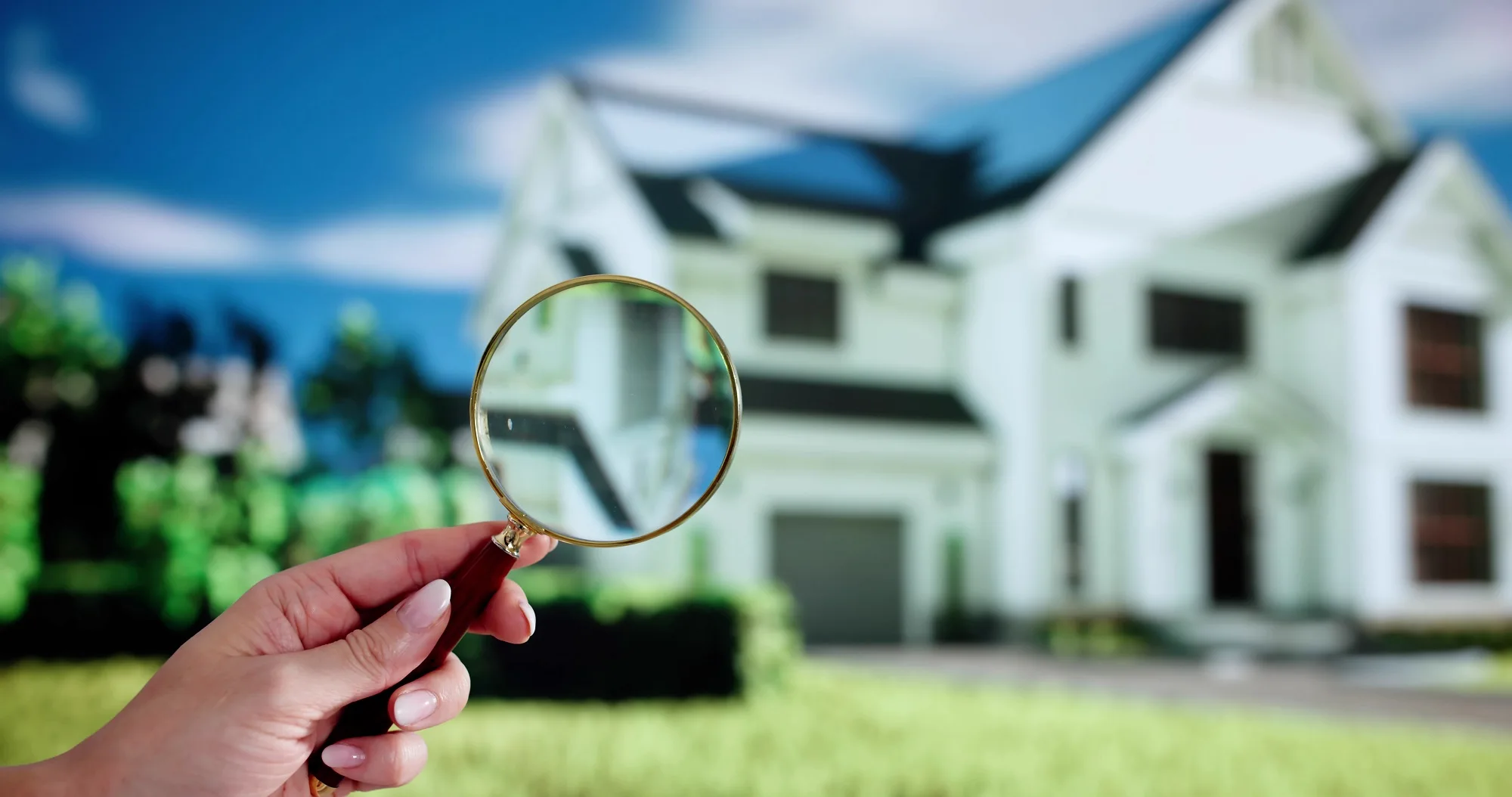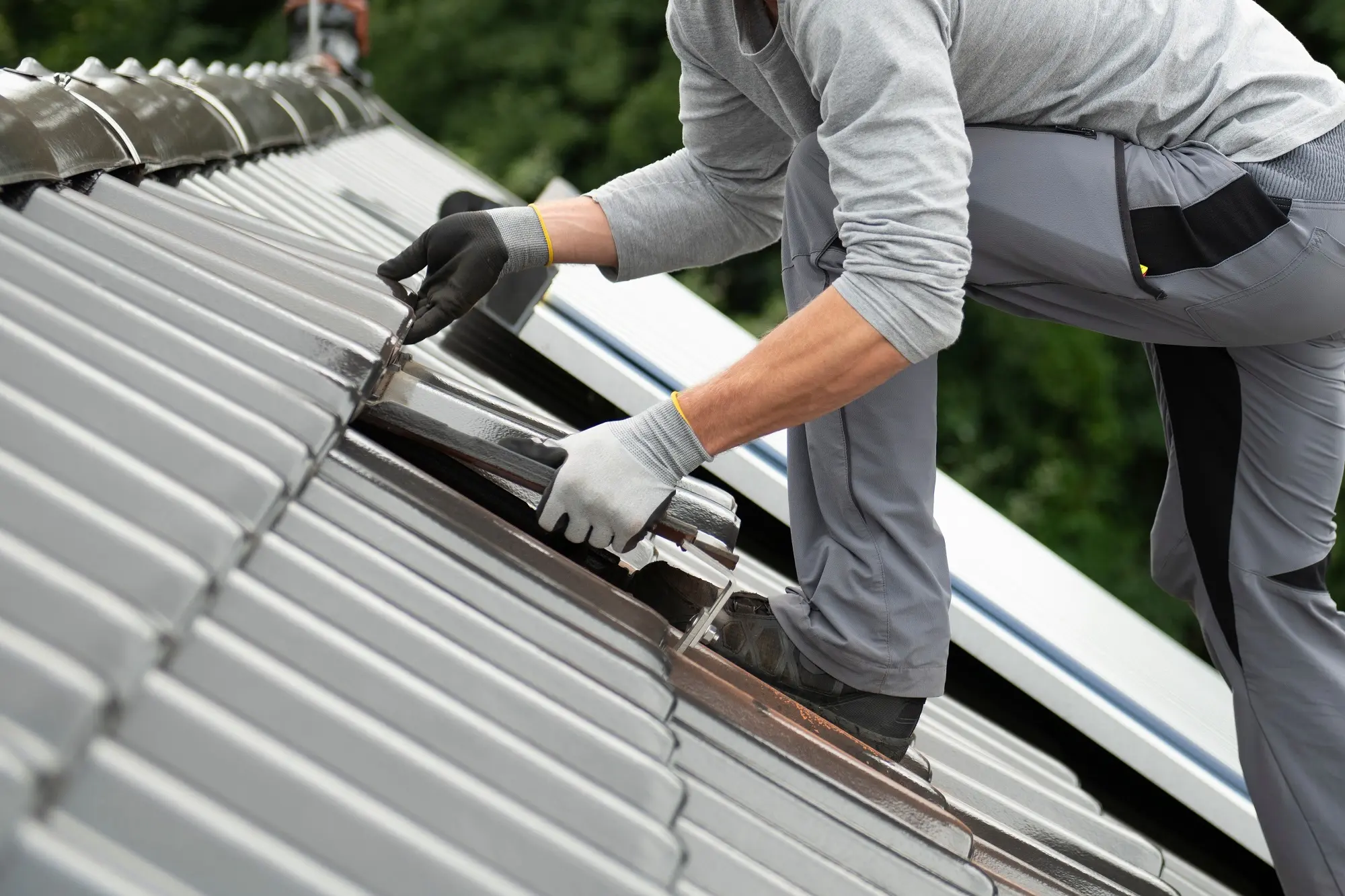This guide breaks down how to check your roof without taking risks. We’ll show you what to look for from the ground and explain when it’s time to call in a professional. If you’re ever unsure, don’t push it. Your safety matters more than anything you might find.
When Should You Inspect Your Roof?
Timing matters. If you wait too long or check during the wrong season, you could miss signs that your roof needs attention. In Chicago, the weather puts your roof through a lot, so inspections need to follow the patterns we see year after year.
Key times to check:
- After winter storms: Freezing and thawing can loosen shingles and damage the wood beneath.
- Before summer storms hit: Early checks can help you fix weak spots before heavy rain rolls in.
- After severe weather: Strong winds or hail often leave behind damage that’s easy to miss.
- When you get a new roof: Once it’s been tested by the first big storm, take a look to confirm everything’s holding up.
Regular inspections can catch early signs of roof damage before they turn into costly water intrusion problems. Most homeowners should inspect their roof twice yearly, while those with older roofs or specific roofing materials like clay tile roofs may need more frequent checks.
When considering roof inspection cost, a DIY visual roof inspection takes 2-3 hours of your time, while hiring a professional roof inspector in the Chicago area typically costs $200-400. However, catching problems early through regular roof maintenance can save thousands in unnecessary repairs.
Ground-Level Roof Inspection: Your Safe Starting Point
Plenty of roof problems can be spotted without ever leaving the ground. With a clear line of sight and a decent pair of binoculars, you can run a basic exterior roof inspection that highlights visible issues, without stepping foot on a ladder.
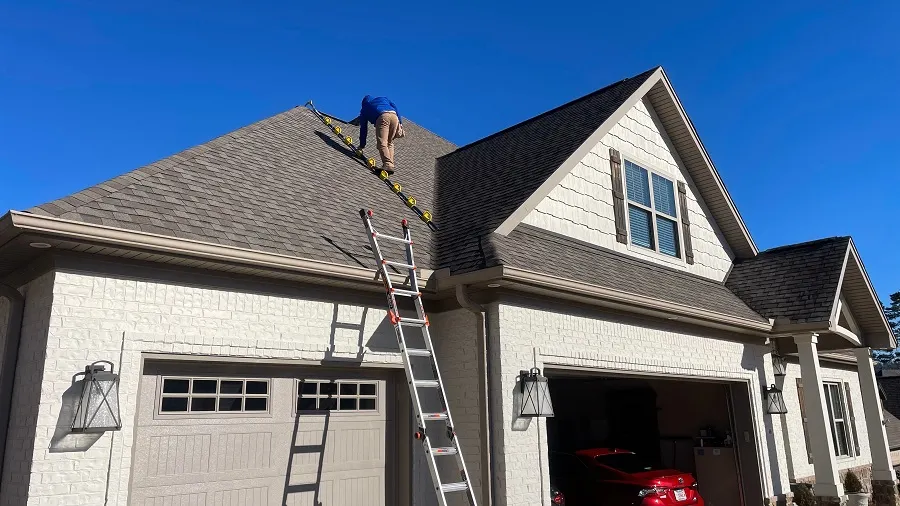
Missing or Loose Shingles
If you notice bare spots or shingles that look crooked, out of place, or appear to be slipping, that’s a clear sign your roof needs attention. These gaps make your home more vulnerable to leaks.
Important note: Even a few missing shingles can give water a path into the wood structure beneath, which can quickly lead to expensive damage if it’s left alone.
Sagging Areas
Your roofline should look clean and straight. Any visible dip or curve might point to a problem under the surface, such as weakened framing or water damage that needs to be addressed right away.
Damaged Flashing Around Chimneys
Take a look at the metal flashing around chimneys, vents, and anything else sticking out of your roof. If pieces are missing, bent, or lifting up, that creates an easy way for water to slip inside.
Clogged Gutters with Granule Buildup
Check your gutters for granules that look like coarse sand. Asphalt shingles lose their protective top layer as they age, and a heavy buildup of granules is often a sign your roof is wearing out.
Key areas to check:
- Water heater vents and other roof penetrations
- Valleys where roof sections meet
- Areas where falling tree limbs might have caused impact damage
A ground-level roof inspection like this often gives you a solid read on your roof’s condition. It can help you decide if everything looks fine or if there’s already water getting in where it shouldn’t.
Attic Inspection: Checking from the Inside
If you want to know how your roof is holding up, start inside. The attic often shows signs of roof damage long before water reaches your ceilings or walls. Catching those early warnings here can help prevent costly repairs later.
Essential Interior Checks
- Water stains on wooden beams: Dark spots or streaks on rafters or joists often mean moisture is making its way through.
- Mold or mildew growth: Persistent humidity or damp air signals a leak above or blocked ventilation.
- Sunlight shining through: If you see light peeking in through the roof deck, there are openings that need to be sealed right away.
- Wet or compressed insulation: If insulation feels damp or looks flattened, there may be an active leak.
- Blocked attic vents: Check that intake vents are clear — poor airflow traps moisture and can damage roof materials from underneath.
Safety note: Always use proper lighting and watch your step when inspecting attics. If you discover significant issues or feel uncomfortable navigating your attic space safely, it's time to contact a roofing contractor for professional inspection.
Close-Up Inspection: When and How to Get on Your Roof
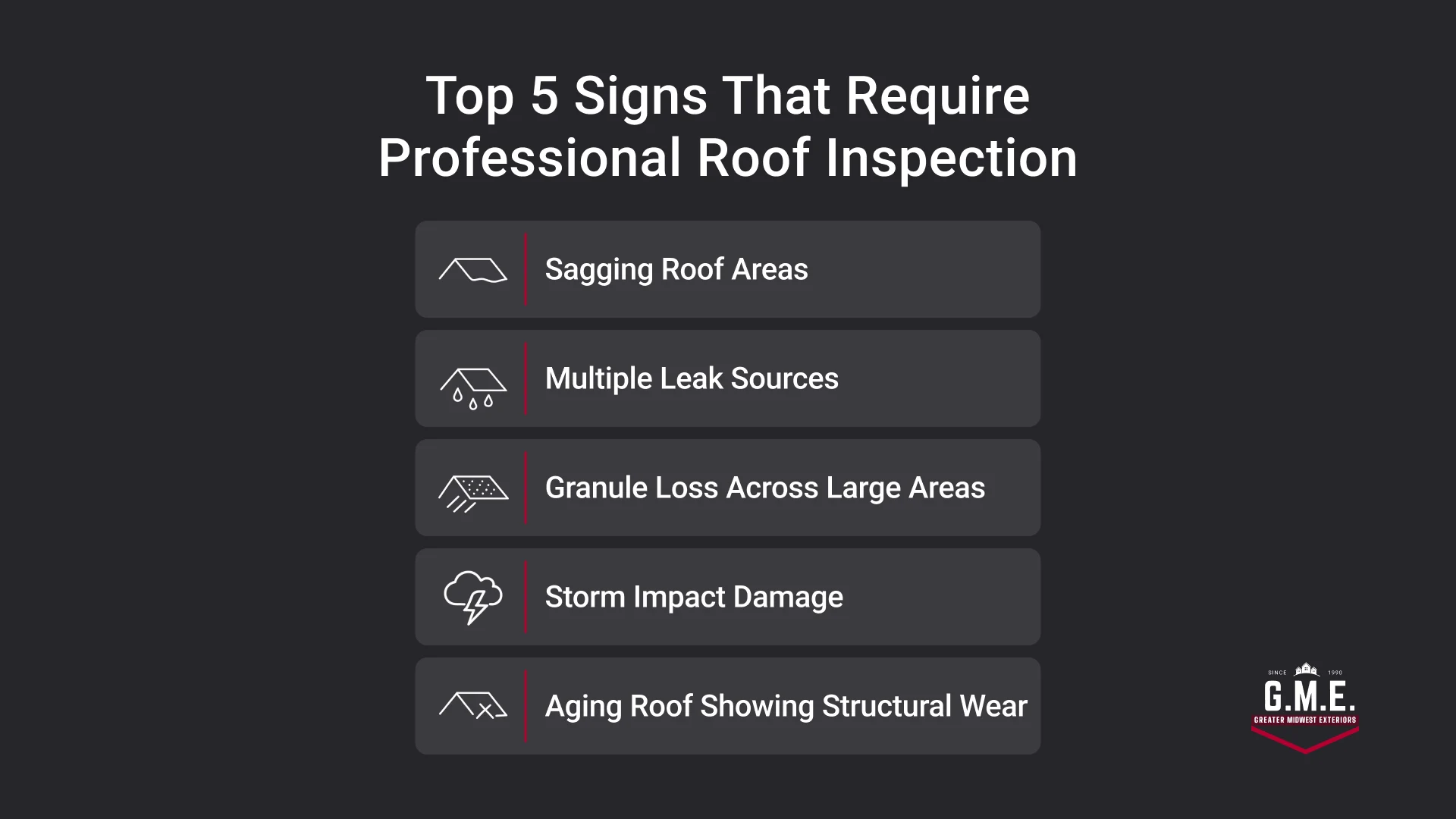
Some homeowners feel confident enough to get on the roof for a closer look. We’ve done this work for years, and we’re happy to explain the safe way to do it — but only if you understand what’s at stake. Always put your safety first. If there’s any hesitation, stay off the roof and call in the pros.
Essential Safety Equipment
Before attempting any close-up inspection, you need proper equipment and ideal weather conditions. Never compromise on safety gear when accessing your roof, as one mistake can result in serious injury.
Required safety equipment:
- Safety harness with proper anchor points
- Non-slip, rubber-soled boots with good tread
- Sturdy extension ladder (extend 3 feet beyond roof edge)
- Work gloves for better grip
- Helper to spot you and hold the ladder
- Cell phone for emergencies
Weather to avoid: Never climb onto a roof if it’s wet, windy, icy, or extremely hot or cold. Only go up on a clear, calm day with completely dry surfaces.
What to Look for Up Close
Granule Loss on Asphalt Shingles
If you see bald patches or areas where the texture looks worn down, your shingles are losing granules. This is a clear sign that your roof’s outer protection is wearing thin and could be due for replacement soon.
Cracked or Curled Shingles
Shingles that curl at the edges or show visible cracks are breaking down from age or weather exposure. These types of damage prevent the shingles from channeling water off the roof effectively.
Important note: Shingles in good condition should sit flat, maintain their full shape, and show consistent color without bald spots.
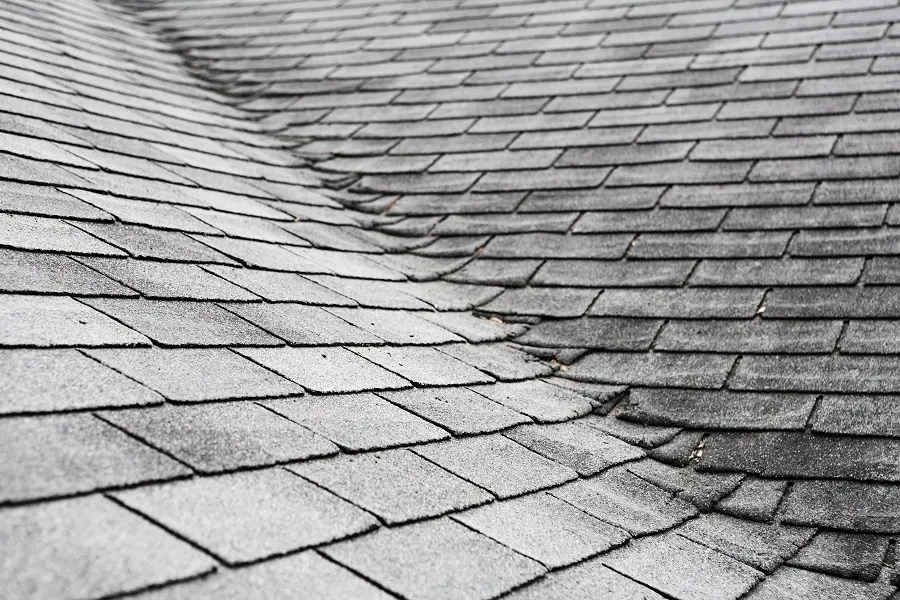
Exposed Nails and Loose Fasteners
Look closely for nails that are popping out or missing. Any spot where a fastener is exposed becomes a weak point where water can seep through.
Damaged Vent Boots and Seals
Inspect the rubber boots around plumbing vents or exhaust pipes. If seals are cracked or missing, those openings can let water into the attic or insulation.
Safety reminder: If your roof has a steep slope (6/12 pitch or higher), is over 15 years old, or shows any sign of structural weakness, stay off it. Call a professional roofing contractor for a safe, thorough inspection.
Table: Roof Inspection Safety Guidelines
Remember, structural integrity issues and complex roofing problems often require specialized tools and training that only roofing professionals possess. When in doubt, prioritize your safety over attempting a DIY inspection.
Drone Roof Inspections
Drones have changed how roof inspections are done. They give professionals a safer, faster way to scan the entire roof without stepping on it. Many contractors now use drones to perform full exterior inspections, and some homeowners are starting to explore this option on their own.
Benefits:
- Safety first: No ladders, no walking on steep or unstable surfaces.
- Full coverage: Drones can reach areas that are too risky for in-person access.
- Detailed visuals: 4K cameras deliver clear images and video, helpful for claims and documentation.
- Budget-friendly: Drone inspections often cost less than a full in-person inspection.
Drawbacks:
- Only checks surface-level: Drones can’t detect deeper structural issues or measure how worn materials are.
- Weather matters: Wind, rain, or snow can keep drones grounded.
- Misses smaller problems: Drones can’t spot soft areas or check small seals and flashing.
- Airspace rules apply: FAA regulations may limit where and when drones can be used legally.
Drones give you great visuals, but they don’t tell the whole story. You’ll get a broad overview of surface damage, but anything beneath the shingles — like rot, leaks, or framing problems — won’t show up. If you're dealing with storm damage, older roofing, or signs of leaking, a hands-on inspection is still the better call.
Identifying Hail Damage: Special Considerations for Chicago
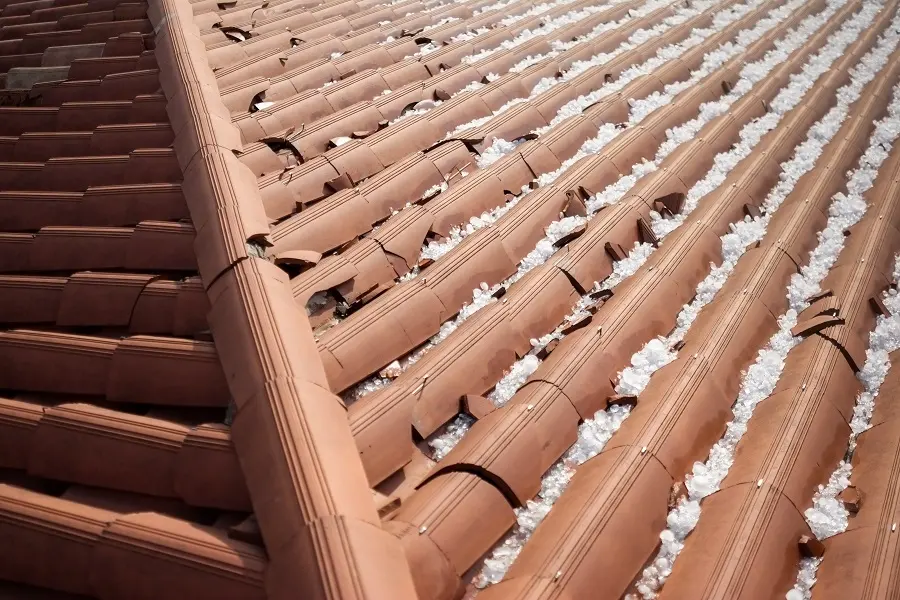
Hail damage isn't always immediately visible to untrained eyes, making it one of the trickiest aspects of roof inspection for homeowners. What looks like minor cosmetic damage can actually compromise your roof's ability to protect your home from future weather events.
Bruising vs. cracking on different materials:
- Asphalt shingles show bruising as dark spots where granules are knocked off.
- Clay tile roofs typically crack or chip rather than bruise.
- Metal roofing shows dents but rarely cracks from hail impact.
Hailstorms are common in the Chicago area, especially during spring and early summer. Damage may not cause leaks right away, but it can still weaken the roof. Even minor hits can void warranties or leave your home vulnerable in future storms. A prompt inspection helps you catch these issues before they turn into bigger problems.
Red Flags: When DIY Inspection Isn't Enough
Some roof issues should never be handled alone. Recognizing when to call a professional protects your home and avoids expensive mistakes. If you spot any of these signs, it’s time to get an expert involved.
Critical situations requiring professional assessment:
- Structural sagging: Any bowing or dips in the roofline may signal deeper structural problems.
- Multiple leaks: Several sources of water entry often require special tools to trace and resolve.
- Widespread granule loss: If large areas of shingles look worn or bare, timing your replacement becomes urgent.
- Post-storm concerns: Damage from wind, hail, or fallen branches is often hidden and easy to miss without a trained eye.
- Roofs near the end of their life: Older systems need a detailed review to assess how much life they have left.
Insurance and documentation: Most insurances cover roof leaks but require professional documentation and assessment. Roofing contractors and licensed home inspectors have the training and liability coverage to make sure you and your insurer are protected throughout the process.


.svg)
